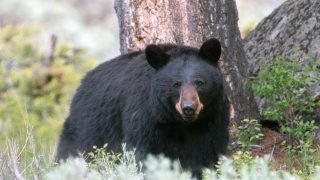
The Animal Legal Defense Fund supports this bill.
Sponsor: Sen. Jesse Salomon (D-32)
Cosponsors: Sens. Adrian Cortes (D-18), Marko Liias (D-21), T’wina Nobles (D-28), Sharon Shewmake (D-42), and Bob Hasegawa (D-11)
Introduction Date: February 06, 2025
A bill being considered in the Washington legislature, An Act Relating to Ensuring Connectivity for Washington Wildlife Through Safe Passages (S.B.5203), would protect wildlife from vehicle collisions and prevent habitat fragmentation by providing safe corridors, such as over- and underpasses, which foster natural wildlife movement and migration.
The state of Washington and partners have built wildlife-crossing structures over and under Interstate 90 and retrofitted one underpass on U.S. Route 97. These structures have reduced wildlife-vehicle collisions by up to 90% in the areas near the crossing structures, showing that this is an effective method of improving wildlife habitat connectivity and public safety.
Washington has developed some of the best wildlife habitat connectivity science in the U.S. The state Department of Fish & Wildlife, in consultation with the Department of Transportation, has begun to develop the Washington Habitat Connectivity Action Plan to synthesize that science and propose priority actions to protect habitat connectivity corridors and facilitate passage of wildlife across the state’s highways.
Similar legislation has been enacted in California, with the passage of the Room to Roam Act, which was signed by Governor Newsom in September 2024 and went into effect on January 1, 2025.
Why is this legislation important?
Vehicle collisions kill over 5,000 deer and 200 elk, hundreds of black bears, cougars, bobcats, and coyotes, and tens of thousands of small mammals and amphibians in Washington state per year. Such losses deplete the state’s natural heritage, not only harming the wildlife themselves but also depriving residents of wildlife-watching opportunities and weakening ecosystem functions required to support human well-being.
Wildlife vehicle collisions with deer and elk alone cost Washington residents over $74 million per year in lost work from injury, medical treatment, vehicle damage, emergency response, and insurance payouts. The reduction in collisions by constructing wildlife crossings, however, saves the state and its residents roughly $235,000 to $443,000 per crossing every year. This does not include the incalculable cost of lost lives of both people and wildlife.
Human development and roads cause loss and fragmentation of habitat, reducing the total area and quality of habitat available to Washington’s wildlife populations, and impeding normal patterns of movement that wildlife need to meet their daily, seasonal, and long-term life history and population-viability needs. For example, Washington lost over 1.1 million acres of forestland to other uses between 1978 and 2019, and over 80% of shrub-steppe habitat has been lost since European settlement.
Climate change is already causing wildlife populations to shift home ranges in search of more suitable habitats. Fragmented landscapes with barriers to movement make it more difficult for wildlife to meet their normal needs and to adapt to climate change.
For more information about animal protection legislation in California and opportunities to take action for animals, visit aldf.org/washington.

